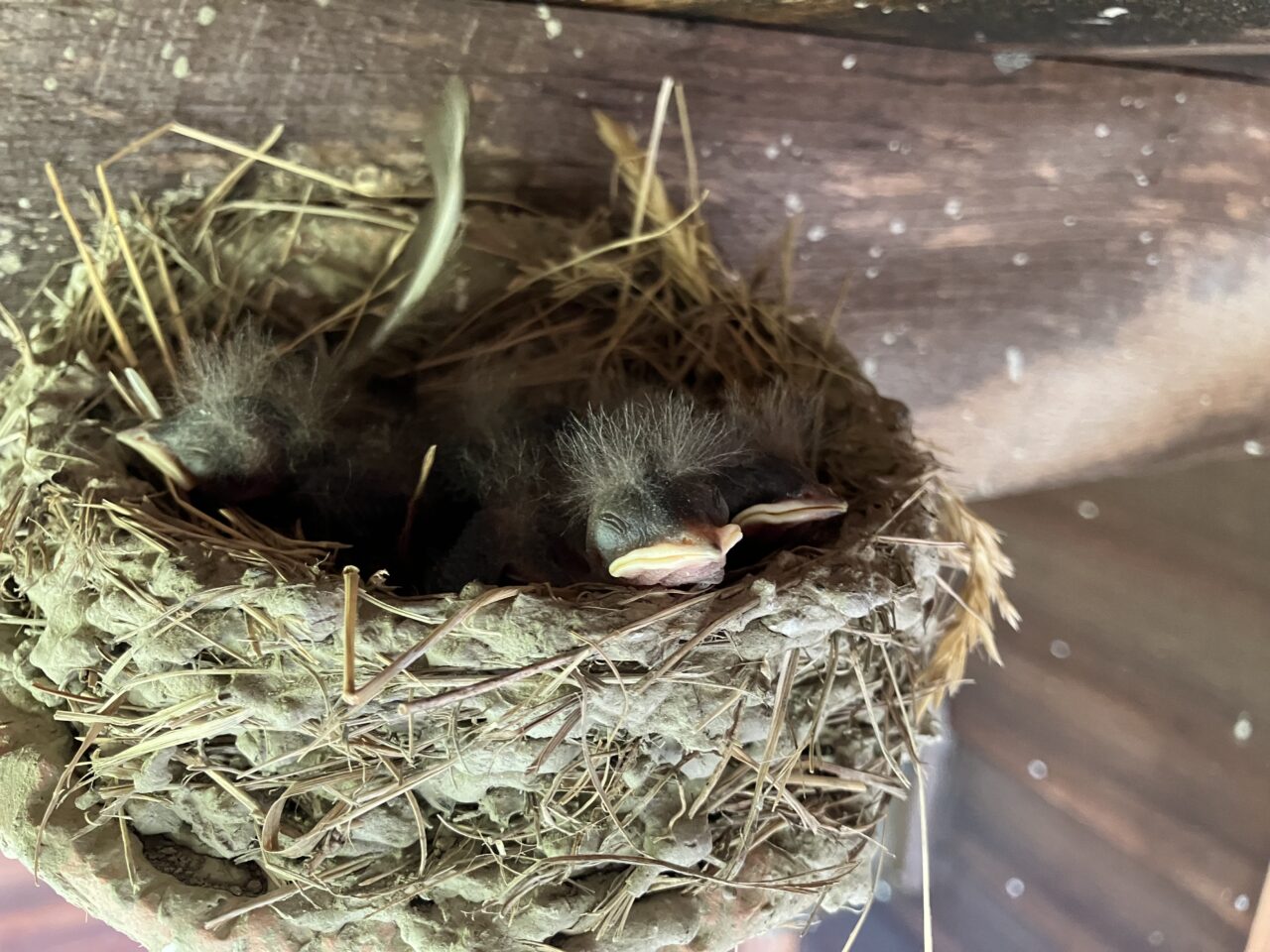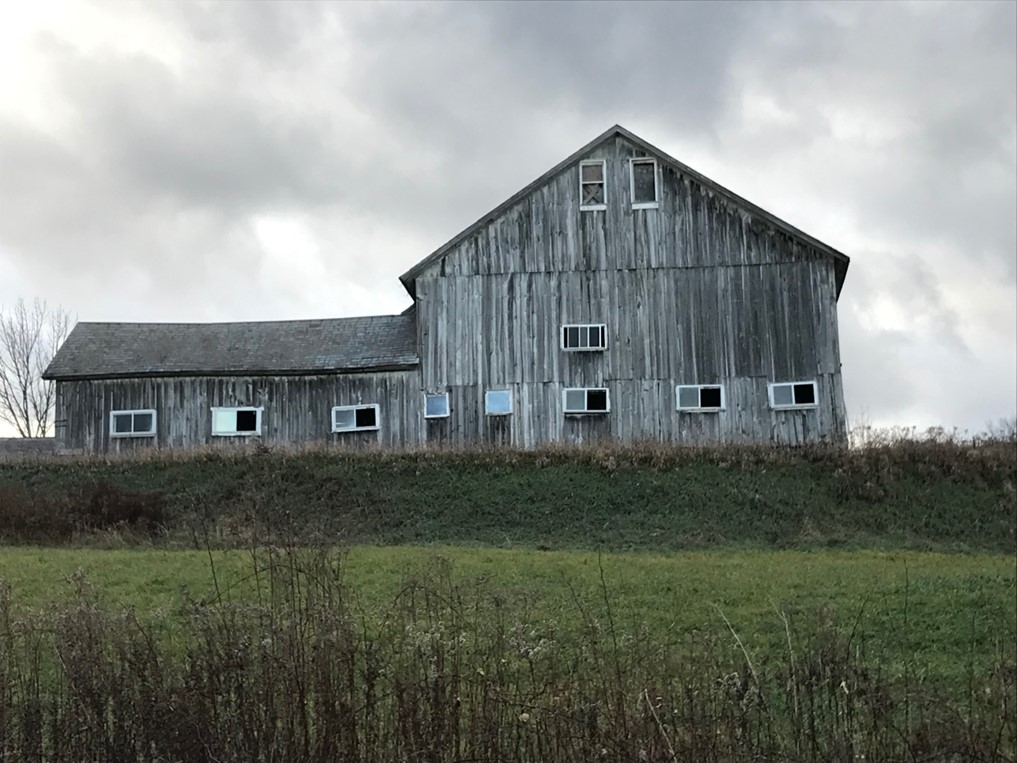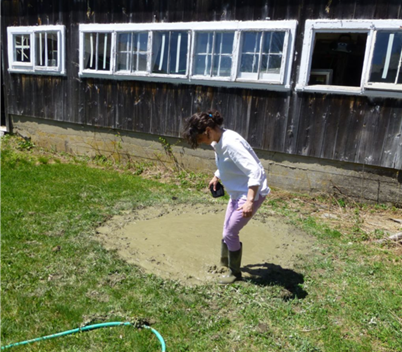Making Space for Barn Swallows
January 30, 2025by Mara Silver, founder of SwallowConservation.org
Almost everyone is familiar with the Barn Swallow silhouette—the streamlined, aerodynamic birds with pointed wings and long, forked tail feathers. Although it may look like they are flying acrobats having fun, they are actually maneuvering in flight to catch insects, their sole food source. Barn Swallows aren’t necessarily faster than other swallows, but they do make faster, tighter turns using their forked tail for stability.

Cozy Cup
Barn Swallows build cup-shaped nests out of mud and grasses like the one above, as opposed to the bottle-shaped mud nests that Cliff Swallows build.
Barn Swallows are popular in culture and often appear in art, symbolizing good luck, a return home, and the return of spring. Another reason for their popularity may be that they nest in close association with people. Barn Swallows have a nearly worldwide distribution comprised of several subspecies, all of which are heavily dependent on human-made structures for nesting sites. It is thought that at one time they nested in caves and on rock faces, but ancient written accounts indicate that they have nested alongside humans for most of our history. In North America, they are commonly found on farms, where they nest inside barns and outbuildings, forage over open fields for insect prey, and collect plentiful mud for nest-building. They also nest under bridges and docks and on other human-made structures. They are often confused with Cliff Swallows, which also nest in close association with humans but, unlike Barn Swallows, construct bottle-shaped mud nests under the eaves of buildings, in culverts, and under bridges (in addition to cliffs).

Home Sweet Hayloft
Barns house more than just farm animals and hay. They're often a preferred nesting space for Barn Swallows.
When small-scale farming started to decline in North America, so did the Barn Swallows. The North American Breeding Bird Survey indicates a 35% decline between 1966 and 2019 (Sauer et al. 2020) and a 74% decline in Canada between 1970 and 2022 (Smith et al. 2024). Since the 1980s, the decline has become even steeper, with Barn Swallows notably disappearing from traditional nesting sites. While the reasons for decline are not known with certainty, several factors may be affecting aerial insectivores in general, such as habitat loss, changes in insect prey, pesticides, and climate change and associated extreme weather events. Barn Swallows haven’t received much conservation attention, perhaps because they still are perceived as a common bird. However, the current widespread declines across most of the continent indicate that conservation action is warranted. Many are surprised to learn that Barn Swallows were listed as Threatened in Canada in 2011, and although the status was changed to Special Concern in 2021, they are still listed as Threatened in Ontario and New Brunswick and as Endangered in Nova Scotia. Some claim that with the loss of human-made structures for nesting sites, populations are retracting to their “natural” level. However, interestingly, even though there are natural nesting sites still available, Barn Swallows consistently use human-made structures instead—and continue to disappear from these.
The positive news is that when conservation measures at the nesting habitat level are implemented, nesting colonies can rebound.

Mud Maker
Create a mud puddle for nearby Barn Swallows. They'll use the mud to help construct their nest!
Experimenting With Attractants
One of my study sites is an 1880s barn that had an active Barn Swallow colony when the farm was in operation through the 1970s. The barn was closed up (denying the swallows access) from the early 1980s until 2012, at which point there was just a single pair nesting in an open horse barn. In 2012, I opened up the entire barn, both the hayloft and lower stanchions, so the swallows could gain access to the interior. I also created a mud source by digging a shallow depression, lining it with lake liner, and filling it with wet soil and natural clay, which I kept wet through the nesting season. Finally, I installed artificial nest cups of my own design in the barn. That same year, three pairs of Barn Swallows nested in the barn and were seen using the mud source. Over the next 12 years, using the same management techniques, colony size gradually increased, until in 2024 there were 15 pairs nesting at the site.
In 2014, I closed off the hayloft area because nests were appearing to become overheated; Barn Swallows generally place their nests very close to ceilings, which makes them vulnerable to heat conducted from roofs. Instead, I opened additional windows in the stanchion area to provide even more access to this area. This is where most of the pairs nest, though over time I have noted that as the colony has grown, swallows are nesting in novel areas, like under the barn in two separate locations. Barn Swallows nest in groups, but they are not highly colonial (Snapp 1976), and some seem to prefer to nest away from the crowd. Barn Swallows are also attracted to old nests (Safran 2006) and often return to the same colony to nest annually (Shields 1984), making it especially important to protect long-held nesting sites. For more details and photos of the process I undertook and the results, visit my website documenting this work.
Not everyone has the appropriate habitat for Barn Swallows, but if you or someone you know does, taking the steps outlined above just may make a difference!
Some Factors to Note:
- Barn Swallows seeking nesting sites will explore upward in a multilevel building, and if there isn’t an open window or door on the top level, they can become trapped because they don’t know to fly back down.
- You can give Barn Swallows a head start on their nests by making a DIY nest platform or by purchasing ready-made clay or wooden options.
- Barn Swallow nests are fairly easy to monitor; just remember not to approach nests after the young are 13 days old, or they may fledge prematurely.
- Monitoring your nests and submitting your data to NestWatch can help scientists better track Barn Swallow populations.
References
- Safran, R. J. 2004. Adaptive site selection rules and variation in group size of barn swallows: individual decisions predict population patterns. American Naturalist 164: 121–131.
- Sauer, J. R., D. K. Niven, J. E. Hines, D. J. Ziolkowski, Jr., K. L. Pardieck, J. E. Fallon, and W. A. Link. 2019. The North American Breeding Bird Survey, Results and Analysis 1966 – 2019. Version 2.07.2019 USGS Patuxent Wildlife Research Center, Laurel, MD. Available at https://www.usgs.gov/tools/north-american-breeding-bird-survey-results-and-analysis.
- Shields, W. M. 1984. Factors affecting nest and site fidelity in Adirondack barn swallows. Auk 101: 780–789.
- Smith, A. C., M.-A. R. Hudson, V. I. Aponte, W. B. English, and C. M. Francis. 2024. North American Breeding Bird Survey – Canadian Trends Website, Data-version 2023. Environment and Climate Change Canada, Gatineau, Quebec, K1A 0H3. Available at https://wildlife-species.canada.ca/breeding-bird-survey-results/.
- Snapp, B. D. 1976. Colonial breeding in the Barn Swallow (Hirundo rustica) and its adaptive significance. Condor 78: 471–480.

10 comments on “Making Space for Barn Swallows”
Hi,
I’m wondering if you can give us any guidance on co-existing with our barn swallow colony. They live in our barn, which they access by an open window near the peak of the roof. There used to be nearly 100 individuals by season’s end; now there are probably closer to 25, including young. We love them and have been upset to see their numbers dwindling, but they do make the barn almost unusable due to the amount of droppings. Do you have any tips for ways we could minimize the mess without driving more of them away? There is an open shelter on the side of the barn where they could nest but they definitely perfer the barn. (Part of the decline in their numbers may have been driven by the fact that we no longer keep horses there, so the big doors are now closed, leaving only that high window.) Any thoughts really appreciated.
Hi Mandy, One thing that may help them to nest on the open shelter part of the barn is to install nest platforms for them. We have free construction plans available on our website here. Placing them may attract the birds on them rather than the barn rafters if other preferences are taken into account (also available on the linked webpage). Otherwise, there’s not much else that can be done, other than to place screening, cloth, or other similar “catches” underneath the areas where nests are most commonly found. That said, I’m unsure how that may affect the desirability of those places for nests, but it may be worth a shot if you’re willing to do some trial-and-error. Feel free to reach out to nestwatch@cornell.edu with any other questions.
I have an unused barn that I keep open for the barn swallows. They come every year. Do I need to do any “maintenance” on their nests? It seems like there is very little room between the top of the nest and the structure above them. Thank you for the article and for taking the time to answer my questions.
Hi David, We often recommend folks remove nests at least once per year to help reduce mite load and keep the nesting area fresh and clean for the following breeding season, but this is up to you, and only recommended if you can do so safely. Some nests may be too high, and it’s okay to leave those if you aren’t able to safely reach them.
If one wants to drastically reduce flies in their barn then welcome Barn Swallows. This also eliminates pesticides.
A short story-when I was a child up until the past 5 to 10 years when it became popular to close off chemneys there now are no (very few) Chimney Swifts in my neighborhood! Pryor to the closures, the sky was full of the birds during summer. I am 80 and have lived here all my life less 3 years. Have charted their arrival and departure for some 30 plus years. Sad to see them go.
Please offer guidance on attracting barn swallows to a south facing sheltered wall.
Herewith background. My net-zero retirement home nears occupancy in Downers Grove, IL The house faces south for passive solar and has a 48″ eave above the second storey to prevent solar gain in the summer, while allowing passive solar thermal in the winter. The sun, at winter soltice, is still blocked from the top 36″ of the south facing wall. We deconstructed the original house in the 100 year flood plain and created a pond and have a small creek in front of the house, and the .8 acre lot is planted with native perenials to attract polinators.
I could place platforms for nests across the 40′ wall and under a similar eave on a 25′ south-facing wall above the garage/workshop. My questions include 1) would this potntially attract barn swallows? 2) What dimensions for platforms that the swallows might use, and 3) what needs to be provided under the people bridge (18′ long) spaning the small crek to attract swallows. Thanks in advance. Tom Casten
Hi Tom, We recommend checking out our Barn Swallow page here, which includes a free downloadable nest platform plan, as well as helpful information such as how high to mount it (them), how far to place them apart from one another, and more. Feel free to send any additional questions to nestwatch@cornell.edu.
I live on Smith Mountain Lake in southern Virginia. A marina we buy gas from used to have many barn swallow nests under the main building, which was built elevated above the water due to flooding. The last few summers, I’ve seen very few nests there. Nothing about the structure has changed. I don’t know if the marina owners have done anything to harass or deter the birds. As a Virginia Master Naturalist volunteer, I’d love to know more about why they’ve disappeared.
We just love barn swallows. Our initial swallows in the spring were Violet Green swallows . We have five boxes for them . We then got a pair of Barn swallows that made a nest high up on an electrical fixture in the horse barn . It was just that pair for several years then another pair attempted to make a nest on the sided of a floor joist . That was going to take some time so i made them a little shelf attached to the bottom of the joist and off they went at great speed and made a nest in one day!!! They come back every year and when they come they have a chatting session with me .. they are so funny . Not the least bit afraid . There are now three nests in the horse part of the barn . They fly together with the Violet green swallows . We have two fresh water ponds , our soil is shale , we live about 400′ from the ocean ( Baynes Sound B C Vancouver Island ) . There are a lot of swallows on the island.
We have swallows every year on the ledge above our front door which has a covered porch. I used to think they were little intruders. Now I look forward to seeing those little fuzzy heads in the nest when they hatch!